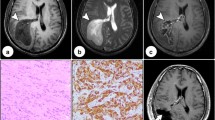Abstract
We present six proven cases of chordoma of the clivus studied by CT and MRI, with special attention to the extent of the tumour and to the signal intensity after intravenous gadolinium. MRI is the best technique for assessing the extent of the tumour but CT is important for showing osteolysis. Our aim was to determine differential diagnostic neuroradiological criteria. Reliable signs of chordoma of the skull base are: posterior extension to the pontine cistern; a lobulated, “honeycomb” appearance after gadolinium; the swollen appearance of the bone in the early stages; bone erosion on CT and frequent extension to critical structures such as the circle of Willis, cavernous sinuses and brain stem.
Similar content being viewed by others
Author information
Authors and Affiliations
Additional information
Received: 20 February 1996 Accepted: 10 October 1996
Rights and permissions
About this article
Cite this article
Doucet, V., Peretti-Viton, P., Figarella-Branger, D. et al. MRI of intracranial chordomas. Extent of tumour and contrast enhancement: criteria for differential diagnosis. Neuroradiology 39, 571–576 (1997). https://doi.org/10.1007/s002340050469
Issue Date:
DOI: https://doi.org/10.1007/s002340050469




